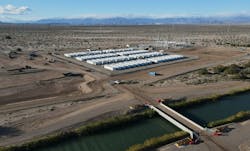SDG&E connects two Battery Storage sites totaling 171 MW in Southern Cal
San Diego Gas & Electric (SDG&E) has completed two additional utility-owned energy storage facilities in California, namely the 131 MW Westside Canal project in Imperial Valley and the 40MW Fallbrook project in San Diego County, totaling 171 MW and equivalent to power 130,000 homes for four hours.
The projects in San Diego County and Imperial Valley have started operating commercially since May and June, respectively, and are made up of stacks of lithium-ion batteries. Both the facilities are equipped with safety features, remote monitoring, and automation technologies.
By the end of 2023, SDG&E expects its energy storage portfolio to have a total power capacity of 345 MW, which will be more than enough to cover over 15 percent of its customers' load on an average day and 7 percent on a system peak day.
Related story: SDG&E adds four BESS Microgrids
Read our latest ET Newsletter: Solar in the Heart of the Oil Sands and more
"Energy storage can soak up surplus renewable energy during the day, so solar and wind farms don't have to cut off production when demand on the grid is low," said SDG&E's Vice President of Energy Innovation Miguel Romero. "By extending the availability of clean energy to peak evening hours, energy storage can also help California achieve its clean energy goals by reducing reliance on conventional power plants to meet peak electricity demand."
The California Independent System Operator (CAISO) is able to store and dispatch clean energy from the facilities as required to meet the electricity demand as these energy storage assets participate in the energy markets under CAISO's management.
"With our state experiencing more frequent climate extremes such as record heat waves and droughts, it is essential to invest in innovations like energy storage to make sure we can continue to power the world's 4th largest economy reliably," said CAISO President and CEO, Elliot Mainzer. "The rapid growth of energy storage in California in recent years gives me optimism about our state's future and its capacity to respond to climate change."
